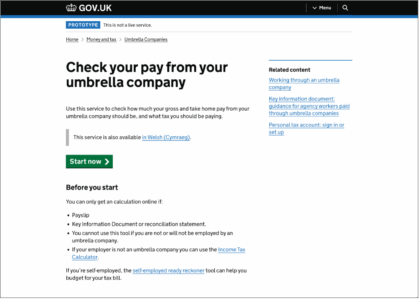
Design Sprint with HMRC produced a prototype to help umbrella workers understand pay
How a design sprint with HM Revenue and Customs (HMRC) led to a prototype that helped umbrella company workers understand their pay
Despite a well-established process in the Service Manual, where discovery leads into alpha, beta, and live, solving problems in government is rarely simple. Systems are complex, there are lots of moving parts, and there is a risk of either solving the wrong problem or delivering something that misses the mark.
Sometimes, the best approach is to start small, test ideas, get real user feedback quickly, and ensure that you’re solving the right problem in the right way.
Having previously worked as a contractor, I experienced firsthand the confusion that came with IR35 legislation and umbrella company arrangements. So when we had the opportunity to work with HMRC to help umbrella company workers understand their pay, deductions, and tax obligations it felt especially relevant.
The challenge: a complex system that leaves workers unsure of their actual earnings
Umbrella companies sit in a complicated corner of the UK’s labour market. These companies handle payroll for temporary workers, but it’s not always clear whether workers are being paid the right amount or taxed correctly. Non-compliant practices, whether deliberate avoidance schemes or honest mistakes, can leave workers underpaid or facing unexpected tax bills.
The impact?
- Workers don’t know if their take-home pay is right.
- The companies that the workers are placed with and recruitment agencies struggle to guide them.
- HMRC gets drawn into compliance cases after the damage is done.
A design sprint to help users find clear, trustworthy and definitive answers
To help HMRC find the answers, we proposed and facilitated a four-day design sprint. It’s a structured way to rapidly clarify the problem, explore potential solutions, and test whether a tool might work before committing to months of development.
A sprint like this doesn’t replace a full discovery, but it can help teams align quickly, gain confidence in the direction, and move forward.

What made this approach valuable?
- Early alignment. Stakeholders, policy leads, and delivery teams worked together from day one, with support from our research and design team – Steven, Gemma, and Ellie. The sprint helped to visualise a potential solution, focusing efforts where they mattered most: delivering tangible value to workers who needed clear, trustworthy answers about their pay.
- Rapid prototyping. By the end of Day 3, the team had created a high-fidelity prototype using GOV.UK Design System – something concrete and easy to understand that could be tested straight away.
- User validation. Real users tested the prototype, validating assumptions while also providing insights needed to take the solution forward.

What the sprint revealed
Users responded positively to the prototype:
- The tool felt authoritative because it came from HMRC.
- It clearly displayed deductions and helped workers feel in control of their pay.
- Payslip validation was a crucial feature that met a clear user need, helping workers verify their pay and deductions.
But the sprint also uncovered barriers to adoption:
- Some users found tax terms confusing.
- Some workers didn’t realise they should be checking their pay in the first place.
- People wanted the ability to upload their pay slips and get an instant check.
A service built on real user needs
Throughout the sprint, we kept the focus on workers and their needs. Their priorities were clear:
- Clarity – users wanted plain language and no jargon.
- Confidence – they wanted to be sure they weren’t being misled or underpaid.
- Speed – they didn’t want to rely on recruiters or wait for help.
Following the sprint, HMRC’s “Work out pay from an umbrella company” tool was implemented and is now live on GOV.UK.
What does HMRC’s tool do?
- It provides a simple, step-by-step check for umbrella company workers and employment businesses to estimate take-home pay and see deductions.
- It breaks down pay deductions in a way that’s easy to understand.
- It helps spot potential issues early before they escalate into compliance cases.
It’s a great example of how government teams can work at pace, test ideas, and build confidence before scaling up. The sprint gave HMRC a blueprint to move quickly, reduce waste, and make a real difference for the people who needed it most.
Why this way of working matters
More than ever, government teams need to act quickly, spend wisely, and deliver real outcomes. But moving fast doesn’t mean skipping the important steps. It means finding smarter ways to test ideas, reduce risk, and build confidence in what comes next.
This sprint showed how starting small can:
- Reduce waste by testing assumptions early; the prototype demonstrated how costly compliance cases could be avoided for HMRC while improving outcomes for workers.
- Move faster by compressing weeks or months of work into a few focused days
- Work more effectively by bringing policy, delivery, and user insight together from the start
- Build in-house capability by handing over tools, not creating dependencies.
How can we help you?
Design sprints are a practical way for public sector teams to untangle complex challenges. They help define the right problem, test solutions early, and build the confidence to move forward. We ran this sprint with HMRC to tackle a long-standing challenge and left them with a working prototype, a clear direction, and the tools to move forward.
The result? A live tool that we can see is helping workers and their employment businesses to better understand umbrella company pay and prepare for upcoming policy changes.
Because when services work better for users, they work better for the government too.
If you’re looking to explore complex challenges in a structured way or want to train your teams to run effective design sprints, we can help.
Get in touch to discuss how we can help you find the right solutions faster.
